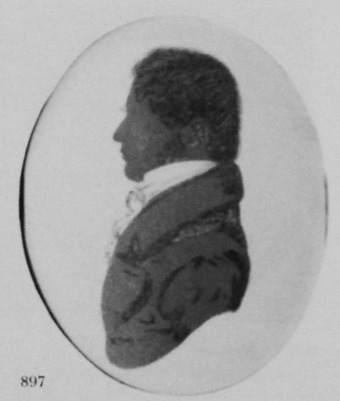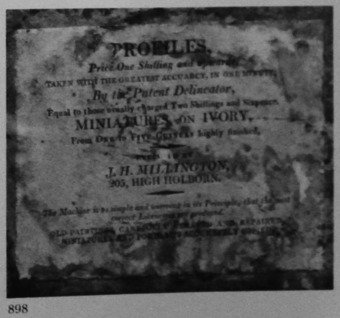Millington, James Heath (McKechnie Section 2)
Recorded as J. H. Millington by Jackson (Dictionary) and as James Heath Millington (supposedly a different artist) by Foskett and Long. Trade Label No. 2 of the profilist, however, which Jackson apparently had not seen, makes it clear that all three authorities refer to the same artist: the label offers both profiles and miniatures painted on ivory, and the known dates given by these authorities are coincident. Millington was, however, chiefly important as a miniaturist.
He was born in Cork, where (after spending several of his early years in England) he is known to have worked as a miniature painter in 1821 at 22 Patrick Street. Later in the year he moved to Dublin. By 1826 he was back in England, where he entered the Royal Academy Schools on 1 April and won prizes, including a silver medal awarded for the best drawing from ‘the antique’. Still a Royal Academy student, he attended the funeral of Sir Thomas Lawrence in 1830. He exhibited at the Royal Academy between 1831-70 and was for a short time Curator of the school of painting there. He died at 3 Chepstow Place, London, on 11 August 1872.
Miniatures are recorded, with dates added to signatures, from 1818 until at least 1836. Foskett describes Millington's miniature work as sometimes resembling that of A. E. Chalon, an artist who often made copious use of gum arabic. A silhouette by Millington (illustrated), backed with Trade Label No. 2, has the same characteristic. It appears to date from the late 1820s, when Millington was still at the Royal Academy Schools. Long recorded some small water-colours, executed c. 1836-8, which he described as ‘sketchy, but pleasing and expressive’.
It will be seen from the trade labels that Millington describes himself, with his other activities, as a copyist (he had already won a prize for copying in 1826).
It seems likely that Millington painted his few known silhouettes as a means of augmenting his income while he was still studying at the Royal Academy Schools. During this period he also produced miniatures, some of which may have been profile miniatures in colour on card. His two trade labels tell us that he worked as a silhouette artist at 205 High Holborn. One silhouette (bearing Trade Label No. 1) was sold from the Desmond Coke collection by Sotheby and Company, London, in July 1931; another, of a woman, was sold from the collection of R. W. Mudie at the same auction house on 11 February 1932.
Millington, who used mechanical means to secure the outline of a profile, refers to his machine as the ‘Patent Delineator’. This machine is discussed in die entry on Mrs Bristowe in Section One; we do not know whether the un-named artist (referred to there) who used it was Millington, or some other artist. More than one model of the machine may have been made, and consequently more than one artist may have used it.
To judge from the number of exhibits listed by Graves, Millington must eventually have become an artist of some repute in England. Graves mentions that he specialized in portraits, and that his work dates from 1831-70; as many as fifty-seven examples are listed during this period. Exhibits at the British Institution (1833-57) include allegorical subjects as well as portraits. During this period Millington worked at the following addresses in London: 75 Newman Street, 33 Henrietta Street, 61 Berners Street, 77 Newman Street, 5 Chepstow Place.
The examples of Millington's portrait miniature work illustrated by Foskett are painted in dissimilar styles; one (No. 589), of a young woman dressed in the fashion of c. 1790-92, is probably an example of Millington's aptitude for copying the work of an earlier artist (perhaps Andrew Plimer or Cosway in this case). Trade Label No. 2 mentions that he copies miniatures and portraits. No. 588 may perhaps be a miniature painted from life during the 1830s. Certainly, the quality of work produced by Millington after he had abandoned the painting of silhouettes was higher than his few early silhouettes would suggest.
Millington painted his silhouettes in black water-colour of a not very dense shade, with gum arabic applied in thick, coarse strokes to show detail and to stress the darkest parts of the profile. An example of this is the profile of a man illustrated in Chapter Two. On this the sitter's stock and collar are left white, their shape being indicated by the use of thinned pigment, but the hair is painted in gum arabic. Where this medium is most thickly applied some peeling is evident. A silhouette of a woman (recorded by Jackson) appears to have been similar, for she notes ‘face and bust black, no gold on neck frill or cap, with white unrelieved’.
As a miniaturist, Millington signed his work either ‘J. H. Millington’, with the year, or simply ‘JHM’, with the year. As a silhouette artist during the 1820s, he used at least two trade labels. No. 1, recorded by Jackson from a silhouette in the Coke collection, does not mention portrait miniatures. It reads:
PROFILES
One shilling, taken with the greatest accuracy in One Minute by the Patent Delineator, ornamented with neat gilt edge and fancy border, equal to those charge 2s. 6d.
Executed by J. H. Millington
No. 205, High Holborn.
The Machine is so simple and unerring in its Principle that the most correct Likenesses are produced.
N.B. Portraits and cabinet Panelling, old Pictures carefully touched, cleaned and varnished.
Trade Label No. 2 reads as follows:
PROFILES
Price One Shilling and upwards,
TAKEN WITH THE GREATEST ACCURACY,
IN ONE MINUTE,
By the Patent Delineator,
Equal to those usually charged Two Shillings and Sixpence,
MINIATURES ON IVORY,
From ONE to FIVE GUINEAS highly finished,
EXECUTED BY
J. H. MILLINGTON,
205, HIGH HOLBORN.
The Machine is so simple and unerring in its Principle, that
the most correct Likenesses are produced.
OLD PAINTINGS, CAREFULLY CLEANED AND
REPAIRED, MINIATURES AND PORTRAITS
ACCURATELY COPIED.
It is evident that by the time the artist was using this label, he was sufficiently expert to compete with other artists in the field of miniature-painting in colour on ivory.
897
Ills. 5, 897, 898

Silhouette painted by J. H. Millington, an artist who almost certainly painted miniatures as well as profiles, photographed ‘across the light’ to show the liberal use of gum arabic. In this photograph all the light parts are covered in gum arabic. (cf 894, in which this silhouette is also illustrated, but photographed in normal conditions).
T. E. F. Sainsbury collection
SECTION TWO

Unknown man
Silhouette painted on card, in grey, with detail in gum arabic
Late 1820s
3¼ x 2½in./83 x 64mm.
Trade Label No. 2
T. E. F. Sainsbury collection

Trade Label No. 2 of J. H. Millington, fro the silhouette shown in 897.
T. E. F. Sainsbury collection
